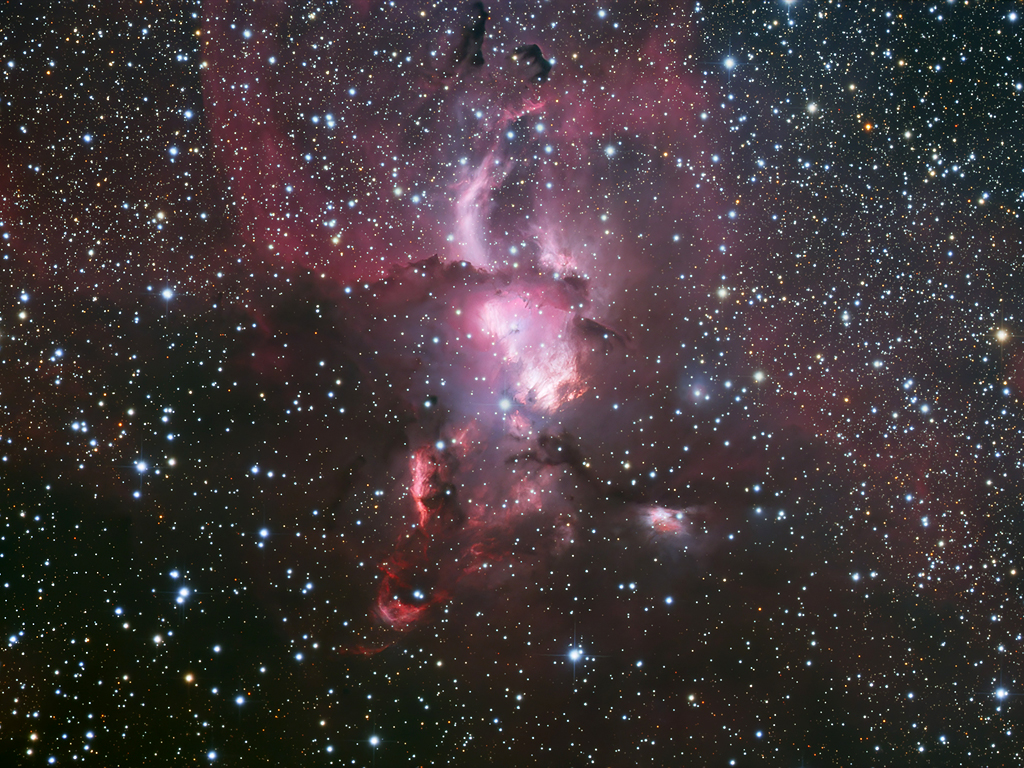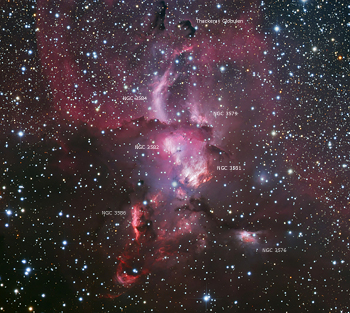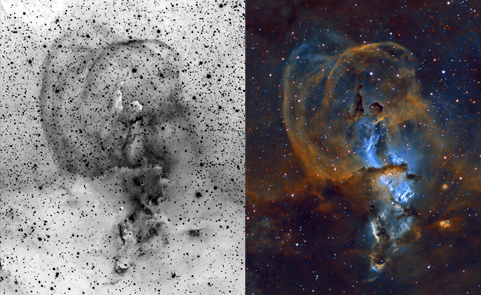 |
CHAMÄLEON + ONJALA OBSERVATORY DeepSky | SITEMAP HOME CHAMÄLEON |
|
 |
|||
| « zurück zur Startseite
galaktische Nebel « back to home galactic nebula |
Großes Bild laden - load large
image 2048 x
1400 Pixel Aufnahmedaten Image data |
NGC 3579 - Star formation in the constellation Carina

NGX 3579 Unser Bild zeigt den Zentralbereich von NGC 3579 (RCW 57) in hoher Auflösung. Es ist eine H-II Sternentstehungsregion und liegt im Carina-Sagittarius Spiralarm unserer Milchstraße. Die Entfernung zum Sonnensystem beträgt etwa 9.000 Lichtjahre. Sie besteht aus den einzelnen Regionen NGC 3576, -3579, -3581, -3582, -3584 und NGC 3586.
Das Gebiet ist aufgrund zweier größerer Einzelobjekte bemerkenswert. Es sind zum einen die "gekrümmten Hörner" oben im Zusatzbild (siehe unten). Diese Filamente sind das Ergebnis stellarer Winde, die von den heißen und junge Sternen in der Zentralregion des Nebels ausgehen. Sie haben Staub und Gas über hunderte Lichtjahre nach außen transportiert. Zum anderen sind im oberen Bildbereich sind mehrere dunkle Silhouetten zu erkennen, so genannte Thackeray Globulen. Es sind Bereiche, in denen in Zukunft neue Sterne entstehen können. Die Nebelregion wurde am 14. März 1834 von John Herschel entdeckt.
Object description
 |
NGC 3579
Our image shows the central region of NGC 3579 (RCW
57) in high resolution. It is an H-II star-forming region and lies in
the Carina-Sagittarius spiral arm of our Milky Way. The distance to the solar
system is about 9,000 light years. It consists of the individual regions
NGC 3576, -3579, -3581, -3582, -3584 and NGC 3586.
The region is remarkable due to two larger individual objects. Firstly, there are the "curved horns" at the top of the additional image (see below). These filaments are the result of stellar winds emanating from the hot and young stars in the central region of the nebula. They have transported dust and gas outwards over hundreds of light years. On the other hand, several dark silhouettes, so-called Thackeray globules, can be seen in the upper part of the image. These are areas where new stars may form in the future. The nebula region was discovered by John Herschel on March 14, 1834. « Klicken Sie hier oder auf das Vorschaubild zum Laden eines großen Bildes mit Objektbezeichnungen. « Click here or on the thumbnail to load a large image with object annotations. |
| Das
Zusatzbild zeigt die beiden gekrümmten
Hörner, links im H-alpha Spektralbereich und rechts, aufgenommen mit
Schmalbandfilter. Das H-alpha Bild wurde vorr über 25 Jahren noch in
damals üblicher CCD Technik mit einer SBIG ST-10-XME aufgenommen.
Klicken Sie hier oder auf das Vorschaubild zum Laden einer großen Version. » The additional image shows the two curved horns, on the left in the H-alpha spectral range and on the right, taken with a narrow-band filter. The H-alpha image was taken over 25 years ago with an SBIG ST-10-XME using CCD technology, which was common at the time. Click here or on the thumbnail to load a large version. » |
 |
Image data
22.05.2022 - 12 x 600 s, QHY ALccd 12 (cooled)
Telescope: PlaneWave CDK 12.5" Astrograph + 0.8x Reducer at f = 2030 mmm
Location: Chamäleon Observatory, Onjala Lodge, Namibia
Image acquisition and processing: DeepSkyStacker, PixInsight + Photoshop by Bernd Gooßmann
 |
 |
 |
 |
 |
 |
 |
| Sonne | Mond | Sonnensystem | DeepSky | Weitwinkel | Verschiedenes | Spez. Projekte |